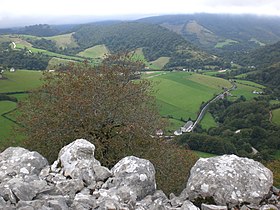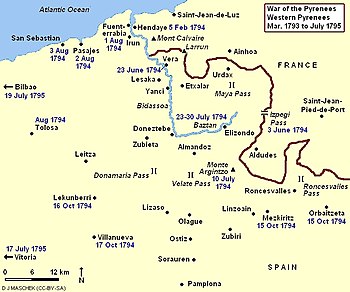Battle of Orbaizeta
| Battle of Orbaizeta | |||||||
|---|---|---|---|---|---|---|---|
| Part of theWar of the Pyrenees | |||||||
 Terrain south of Orbaizeta | |||||||
| |||||||
| Belligerents | |||||||
|
|
| ||||||
| Commanders and leaders | |||||||
|
|
| ||||||
| Strength | |||||||
| 46,000[1] | 13,000[1] | ||||||
| Casualties and losses | |||||||
| Not known[1] | 4,000, 50 cannons[1] | ||||||
TheBattle of Orbaizetawas fought from 15 to 17 October 1794 during theWar of the Pyrenees,between the FrenchArmy of the western Pyreneesled byBon-Adrien Jeannot de MonceyandSpanishforces under the command ofPedro Téllez-Girón, 9th Duke of Osuna.Part of the widerFrench Revolutionary Wars,this engagement was fought over a wide area to the northwest and northeast ofPamplonainNavarreand ended in a French victory. The Spanish defenders gave up territory to the north of Pamplona, including a number of strategic locations.
Background
[edit]While 1793 saw no important battles in the western Pyrenees, the following year saw significant action. WithGeneral of Division(MG) Jacques Léonard Muller leading the Army of the western Pyrenees, minor engagements occurred atHendayeon 5 February,[2]Izpegi Passon 3 June,[3]and atBera(Vera) on 23 June.[4]In late July, Muller put MG Moncey in charge of three divisions, including his own and those of MGHenri Delabordeand MG Jean Henri Guy Nicolas de Frégeville. With this force, Moncey won theBattle of the Baztan Valleyand followed up his success by capturingPasaia,San SebastiánandTolosa.Promoted to command the army for his great success, Moncey planned to lay siege to the Spanish fortress of Pamplona.[5]
Battle
[edit]On 15 October 1794, Moncey launched an offensive on a broad front with 46,000 troops. Commanding the French divisions were Generals of Division Delaborde, Frégeville, Jean Mauco,Thomas-Alexandre Dumas,andJean-Antoine Marbot.Generals of BrigadeAntoine Digonet,Pierre Rouché (Roucher), Louis Hyacinthe Le Feron, Pierre Bories de Castelpers, and Jean Daniel Pinet led brigades during the operation.[1][note 1]Lieutenant GeneralDuke of Osuna commanded the 13,000 Spanish defenders ofNavarre.His commanders were Generals Manuel Cagigal, Antonio Filangieri, Frias, and Marquis de la Canada Ibagniez.[1][note 2]

Moncey launched his offensive from theBaztanvalley, and from the area ofRoncevaux Passto the south toward Pamplona. On the west, the attack was fromLeitzatowardLekunberri.In the center, the direction of advance was fromDoneztebeacross theDonamariaPass and fromElizondoacross the Puerto de Belate (Velate Pass) towardSorauren.In the east, the French moved fromRoncesvalles(Orreaga) southeast to the Rio Urroti valley and southwest to the Rio Irati. Moncey, who had "a particular penchant for encircling movements" hoped to cut off substantial enemy forces.[6]
On 15 October, Delaborde's division attacked Filangieri at Mezkiritz (Mezquiriz), 8 kilometres (5.0 mi) southwest of Roncesvalles. The French deployed 11 infantry and twogrenadierbattalions, plus 640dragoonsandhussars.The Spanish suffered 200 killed and 724 captured out of a total of 4,000 troops engaged, while French losses are unknown.[1]
The French captured Lekunberri on 16 October and Villanueva, 9 kilometres (5.6 mi) farther south, on 17 October. Both villages were at the western end of the line. At the eastern extremity, Orbaizeta fell together with its arms foundry, which was 4 kilometres (2.5 mi) north of the village. The French also captured the Spanish navy's mast store on the Irati and a second foundry at Egui. The offensive stopped short of Pamplona because theRepresentatives-on-missiondid not authorize a further advance.[5]The bulk of the defenders escaped encirclement. One authority faults Delaborde for failing to cut off the Spanish.[7]The Spanish losses numbered about 4,000 soldiers killed, wounded, and missing. In addition, the French seized 50 artillery pieces. French casualties are unknown.[1]
The French inflicted damage on the Spanish army and gained ground closer to the Pamplona fortress. Even worse for the Spanish was the loss of two arms foundries and the navy's mast store. In November 1794, the Spanish suffered a disaster at theBattle of the Black Mountainin the eastern Pyrenees. A deadly outbreak of disease stalled French operations in the western Pyrenees during the winter 1794–1795. In June 1795, Moncey launched a victorious advance to the west, takingVitoriaandBilbao.ThePeace of Baselon 22 July 1795 brought the war to a close. When the news of peace reached the front in August, Moncey's advance was across theEbro,while other forces prepared to invest Pamplona.[6]
Notes
[edit]- Footnotes
- Citations
References
[edit]- Beckett, Ian (1987). "Moncey: An Honest Man". In David G. Chandler (ed.).Napoleon's Marshals.New York: Macmillan.ISBN0-02-905930-5.
- Smith, Digby(1998).The Napoleonic Wars Data Book.London: Greenhill.ISBN1-85367-276-9.
